How do you devise a digital workplace strategy? We all know technology in the workplace has become inescapable. However, the question of developing a digital workplace strategy is a common one.
We all utilise some form of technology in our daily roles, but it can often be a selection of random and unintegrated tools. A digital workplace strategy blends businesses' technology and people and how they intertwine.
This blog is your comprehensive guide to digital workplace strategies, providing practical examples to apply to your business.
The guide will include:
- What is a Digital Workplace?
- What is a Digital Workplace Strategy?
- The Benefits of Adopting a Digital Workplace?
- Key Elements of a Digital Workplace?
- Digital Workplace Strategy Examples
What is a Digital Workplace?
Digital workplaces are the suite of technology that facilitate and help employees do their job. They are key to communication, information and facilitating hybrid or remote working.
Think of a digital workplace as your business's technology hub. Digital workplaces can be software that employees use to communicate, and consume information or a digital tool they use in their daily roles.
Given that 75% of UK employees want a hybrid approach going forward, virtual workspaces are essential.
However, the purposes of a digital workplace stretch far beyond flexible working. They possess the ability to improve efficiency, connectivity and flexibility in any industry.
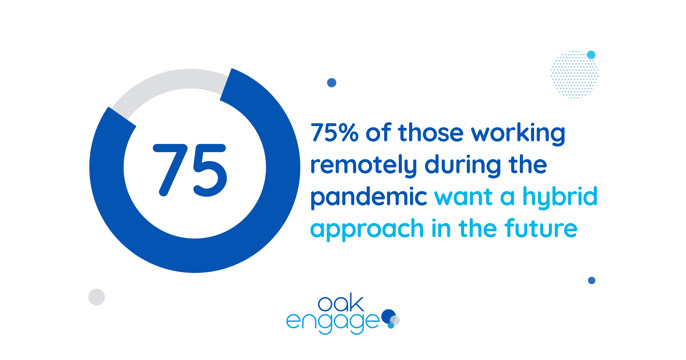
Recommended Reading 📖: What is a Digital Workplace: A Simple Guide
What are Digital Workplace Strategies?
Many organisations rush to implement technology with no defined plan. This can spell catastrophe financially and reputationally.
No matter how urgent the need is, this will create chaotic and unsuitable digital workplaces. A digital workplace strategy is about building a work environment that empowers your workforce. Don’t just implement one for the sake of it.
Digital workplace strategies set out, technology, processes, culture and how they will intertwine. This should be extended to your entire workforce regardless of location or time zone.
Basically, they are a blueprint for your digital workplace.
Why Implement a Digital Workplace Strategy?
Talent Attraction/Retention
In an Oak Linkedin poll, 65% of respondents said they would leave their current role if they were not offered remote work: a further 22% said they would consider it. Clearly, the appetite for hybrid and remote working is now driving the job market. Your business must build virtual workplaces to attract and retain talent.
Employee Productivity
A TechNation Insight report found that 81% of businesses see IT as a strategic enabler of workplace productivity. Leaders see technology as the driving force of improved productivity in employees and are central to any strategy.
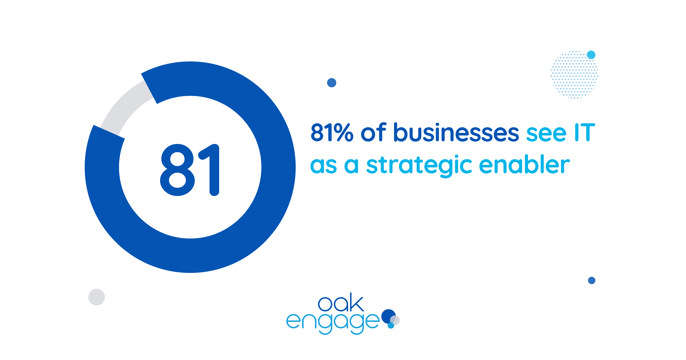
Employee Satisfaction
In a Zensar study, 42% of employees said new technology resulted in better morale. Evidently, technology in the workplace empowers employees. Invariably this will lead to better job satisfaction. This is why it’s so important to get it right and put in a strategy that will help engage and empower your employees.
Communication.
The modern worker prefers newer communication tools. 79% of employees say that modern technology is important in the workplace. This is reflected in 74% of employees saying they feel they miss out on company information. Choosing the right communication tools will help target information to the right people. More modern channels will also help deskless and frontline workers who may not have access to company email.
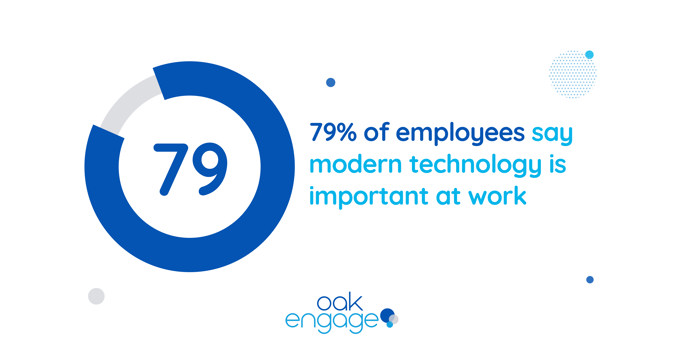
The Benefits of Adopting a Digital Workplace Strategy
A Unified Workforce
Accommodating and maximising the potential of your entire workforce is essential. This includes deskless and remote workers. By mapping out their requirements, you can implement technology that helps connect them.
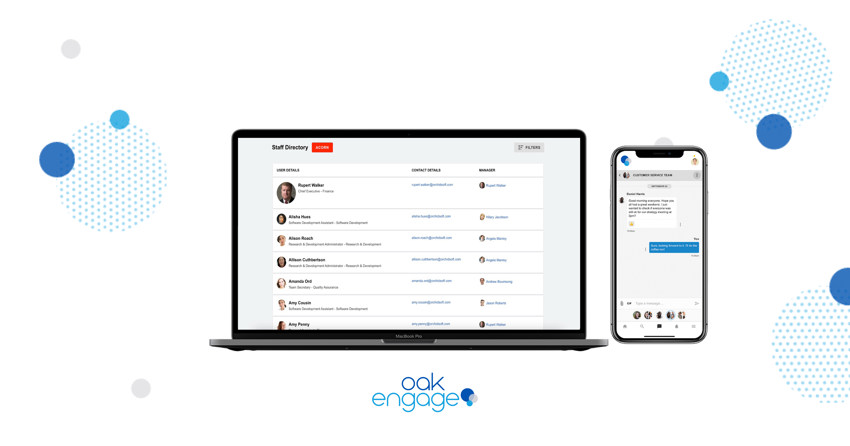
Virtual workplaces offer increased accessibility, connecting previously isolated and remote workers. This does not stop at deskless workers, however. All your employees should have heightened accessibility to the information and resources they need. Spaces to share ideas and chat can in fact boost the collaboration that some think is missing in remote working.
Increased Productivity
The Economist’s Experience of Work study found that employees spend an average of 25% of their day searching for information. That works out at more than one day of the working week!
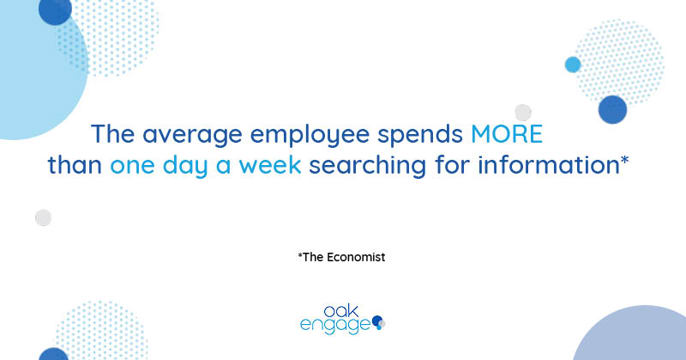
Digital workplaces are designed to connect employees to their roles, companies and teams. That includes access to information. Your strategy will set out clear tools and locations for policy and documentation. By doing this, you give your employees the ability to utilise their time effectively.
This can only lead to increased productivity with the time (and headache) taken away from information searching.
Improved Talent Retention and Attraction
A study from the University of Strathclyde found that 78% do not want to be in the office more than two days a week. For your organisation to be an attractive proposition, you must offer a level of home working.
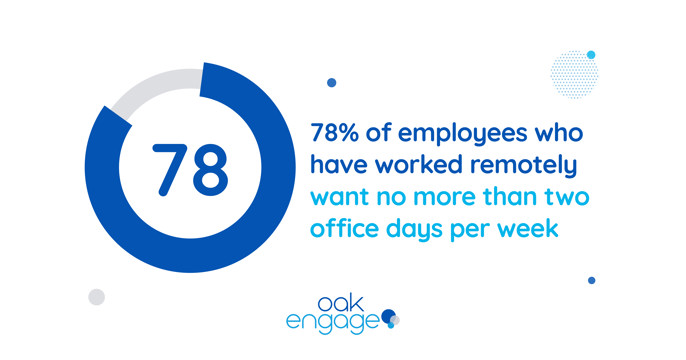
A strategy will aid remote working by aligning technology with process and communication. By eliminating issues related to home-working, you can offer it with less risk.
However, only by creating a fit-for-purpose environment can you do this without harming other areas of the business.
Key Elements of a Digital Workplace Strategy
Goals and Objectives
Your digital workplace strategy should align with business aims. To do this you must also construct quantifiable objectives for your digital workplace to achieve.
Anything other than Specific, Measurable, Achievable, Relevant and Timely (SMART) objectives makes evaluation a guessing exercise.
Furthermore, setting actual targets can help visualise what success means for your business. Some businesses struggle to comprehend transformation until they have something tangible to work towards.
Your SMART objectives should address:
- Awareness - How will you ensure that all affected stakeholders are aware of what and why changes are being made?
- Attitude - Why and how will employees engage with the new technology and processes?
- Behaviour - How will you ensure new technology is used in the right way and new processes are adhered to?
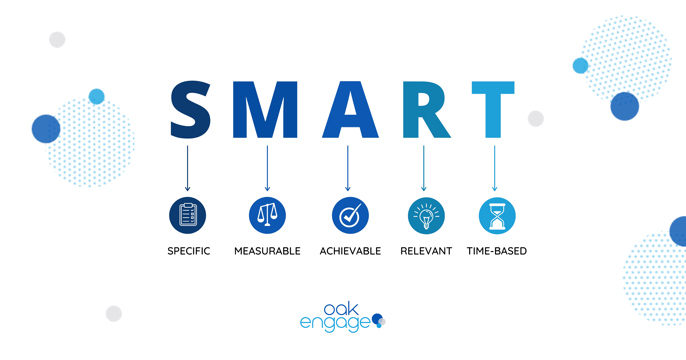
Metrics to Measure
Quantifying all aspects of your strategy from research to objectives is essential.
How can you measure success without the right metrics?
By utilising analytics you will not only make your business aims far easier to measure, but also help to inform strategic decisions.
You can do this in the form of collecting data from employee surveys, current outputs and more. These should be present from the planning stages to evaluating objectives.
In relation to your digital workplace metrics apply to anything technology or people based that you can measure.
Technology to Be Used
Technology is pretty important to a digital workplace, right?
Your entire workforce is the heart of your digital workplace, so choose the right tools and software to connect them all. You can have the most modern, expensive tech in the world. If your employees won't or can't use it then it's pointless.
Accessibility is key, so depending on the makeup of your workforce think about what technology will connect and engage. For instance, if you have deskless workers, look at mobile friendly technology. For remote workers, you need software that facilitates virtual collaboration and connects them to the organisation from afar.
Oak realises that technology connecting all your workforce is key and indeed possible, no matter what the dynamic.
Strategy & Implementation
Creating your digital workplace requires attention through the entire project cycle. To ensure success you must be meticulous from planning to implementation and beyond.
A blueprint for the digital workplace is needed across all departments from IT to sales. In fact, a proper plan for each will help to coordinate departments. Ask the question: how can each department fully utilise a digital workplace? This requires forensic attention to detail.
You must also continue to get the best out of your digital workplace as it develops and how to continuously improve. Doing your research before implementation is key but leadership is still needed as and after the workspace is established.
Training Programme
As you wave goodbye to legacy programmes, train your employees in the new tech. Your employees will be using software completely new to them.
Take the stress away from the unfamiliarity by providing sufficient training. The business won't be ready for change if your employees aren't.
Ways of training employees in new technology are:
- Training led by an in-house expert
- E-learning- videos, online courses, quizzes, etc.
- Product training by an external provider
- Simulation training- learning using a prototype of the technology
In terms of measurable business value, you can take a look at:
- Revenue - Improves the running of the business from manufacturing to sales
- Operational costs - The right technology can cut time, travel, office rent and waste
- Productivity - Provide tools that improve current and create better business processes
- Product releases - New tools to develop test and release new products quicker and more efficiently
- Innovation - Technology facilitates widespread communication and communities where ideas can be shared
- Customer experience - Employees being able to do their job efficiently and feel more engaged will naturally lead to a better customer experience
- Employee experience -Employees will enjoy their job more when they have the tools to do it to the best of their ability
- Attraction & retention - Digital workplaces can project an improved internal and external brand
Other Items to Consider For Your Digital Workplace Strategy
Workplace Processes
Digital workplaces align people and processes if done correctly, so you must understand how employees work now. You should map out your current processes and what they will look like in the new workspace.
A key question you should be asking is: how can technology help to make your current processes more efficient and vice versa? Digital tools can improve best practices and reshape processes.
However, the processes must also support the technology as well as the other way. Technology can not be fully utilised if it and your processes are not aligned. Understanding all current and new processes is important when devising a strategy.
Access to Information
Gone are the days of document storage cabinets and contacts in Filofaxes. So why is information access something businesses still struggle with? You must consider how and where your employees access the information they need.
Oak’s solution houses company information such as staff directories and company policy in centralised and easy-to-navigate locations. Search functions make the exercise of information seeking, a painless one. 25% of the employees’ time spent searching for information can be put to better use.
The way we store information has evolved, so why shouldn't the way we access it?
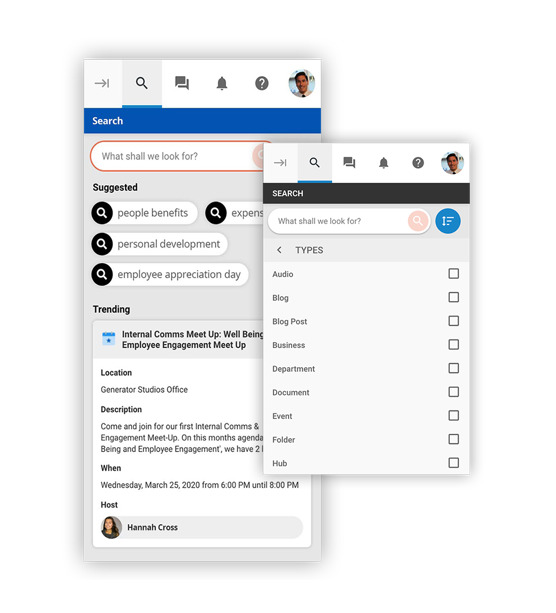
Employee Feedback
Employees are the heart of any workplace. Including them in the planning phase of a major change is critical. Understanding how to engage employees should form the very foundation of a digital strategy.
In evaluating the current landscape you can utilise technology as a means to increase productivity.
You can carry out this research through methods such as:
- Employee feedback surveys
- Polls
- Individual feedback forms
- Meetings with representatives from teams or departments
You can apply the research conducted to your strategy, which actionable data will help inform. Pulse surveys gather insights from your employees and help to gauge the views through the visualisation of research.
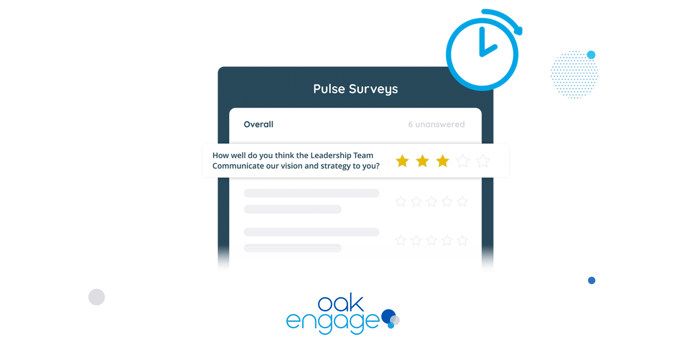
Costs
Costs will be key in getting buy-in from leadership. It is possibly the most difficult conversation to have in digital workplaces. The all important question: how much is it going to cost?
The technology itself can constitute a large share of the cost. But this also extends to training, additional staff and any transitional period that may impair productivity.
Potential ROI from your digital workplace is what matters most in relation to cost. What added output or potential business effect will the digital workplace have? ROI should be at the forefront of your strategy, not the money spent. Presenting this to business leaders is absolutely key when investing significantly.
Reasons Why a Digital Workplace Strategy Fails
Focusing solely on technology and not people
A common issue with new technology in a business is trying to get people to fit the technology and not the other way. The CIPD’s study into Workplace Technology found that only 35% of employees are informed prior to the implementation of new tech.
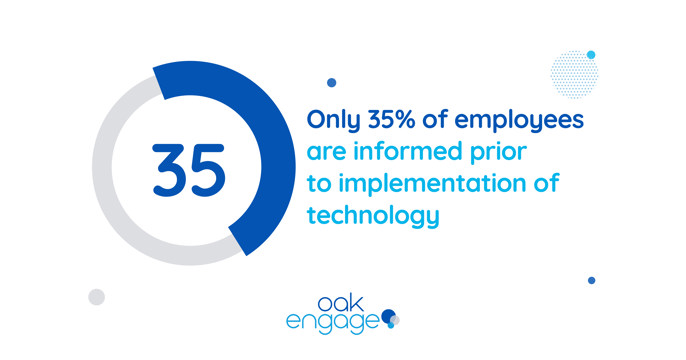
Employees could be lost in a sea of new features and tools added at regular intervals. This is a consequence of no clear vision or purpose for the technology. A lack of employee consultation can cause wasted investment and unfit technology estates.
Not considering accessibility
One drawback of many digital workplace strategies is not considering the added flexibility they bring. Treating it like a traditional workplace is a big no-no.
Deskless and remote workers have traditionally been an afterthought when it comes to the work environment.
However, mobile accessibility offers an opportunity to connect and engage further. By missing this opportunity you are nullifying the benefits of bringing deskless workers closer to the company.
Not aligning with the brand
Using SaaS solutions doesn't mean you can’t personalise and brand your workplace. Digital workplaces are the perfect place to showcase your culture and brand. However, many do not focus on how they can project internal branding and messages.
Branded intranet home pages and custom designs will help to put internal branding at the forefront of your digital workplace. This in turn will help align employees with the company's mission.

Digital Workplace Strategy Examples
Workforces in different industries and businesses have different needs. In your digital workplace, this is no different and must be considered in your strategy. Here are some examples of digital workplace platforms and tools that could be applicable to your business.
Deskless & Shift Workers
Accessibility is key when it comes to devising a strategy for deskless and shift workers. These are most prevalent in industries such as retail, hospitality and healthcare. Where either or both make up a significant part of the workforce, it is vital to provide mobile access.
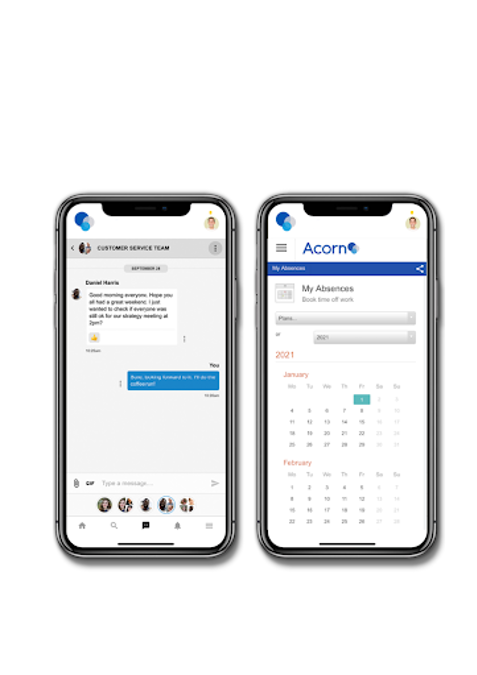
Aldi utilised Oak's mobile functionality, ensuring a 90% engagement rate in their 40,000-strong workforce on the MyAldi app. Mobile centric digital workplaces make life much easier for deskless employees. They give access to rotas, payslips, and push notifications for updates on a single sign-on platform. Fewer things for frontline workers to think about or stress about.
Deskless & Office Workers
With a split between deskless and office based employees, it can be a challenge to connect with them all. Hybrid workforces are particularly common in industries like construction and manufacturing. This emphasises a demand for intuitive software and multi-functional accessibility.
Severfield adopted an information-first approach, boosting content views to 99.5% through intuitive Oak software. User orientated news feeds were created to keep employees updated. Centralised document management took the headache out of searching for information.
Creating spaces to inform and educate can keep your employees connected in the most testing of circumstances.

International or Multi-Location workers
Having a workforce in disparate locations and time zones poses challenges with communication. Businesses with larger workforces face this issue on a regular basis. Oak’s software offered OEC’s 1000-strong workforce a shared experience.
Centralised documentation and company updates would ensure employees were in the know. Messaging functionality and social hubs also improved business and social communication. Seamless integration with connectivity at the heart of the digital workplace makes for more efficient and engaged employees.
The Digital Strategy Framework
This is all well and good but is there a specific path to follow to implement a digital strategy? Whilst every business need is different, this four-layered framework will help you to think holistically to think about the different areas of your strategy.
Collaboration & Communication
Connectivity and collaboration have been key themes throughout this guide, without them the potential of your workers and business is limited. You must choose the tools that empower your employees not only in their own work but in skill and knowledge sharing across the organisation.
Technology
As discussed, all industries and businesses have varying needs. It is important to adopt the right tools that will support your employees. Think about what digital tools you already have in place. What works, what doesn't and what could you improve on all four layers of the framework.
Governance
Any digital transformation must comply with organisation and industry regulations. This means that any technology must support governance structures and processes. Furthermore, technology can improve adherence to governance with automation and AI, omitting some of the risks linked to those processes
Measurable Business Value
Business aims and aims of your digital workplace must be aligned. Your digital workplace strategy should be underpinned by business objectives to ensure the right fit and measurable success.
To Conclude...
The difference in the need for varying industries and business sizes is evident. This is why a strategy is absolutely necessary before a technological brick is laid. We hope that this guide and examples give you information that will be helpful in your digital workplace strategy.
Recommended Reading 📖: Our Intranet Success Stories
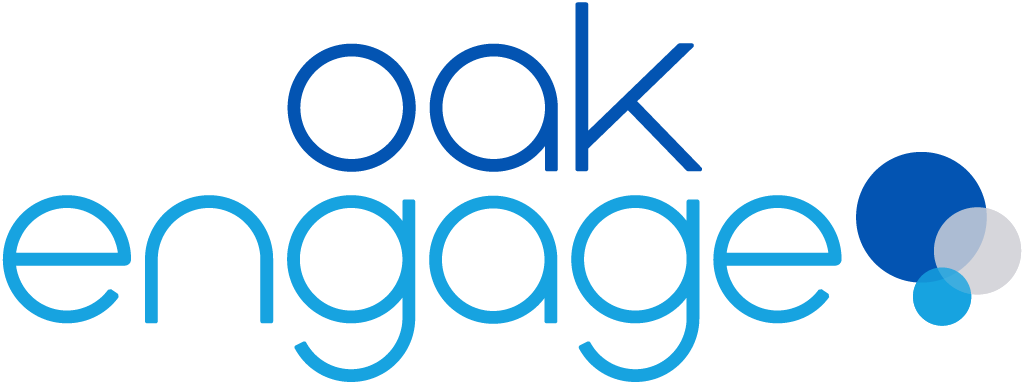

![Digital Workplace Strategy: A Simple Guide [+ Examples]](/media/2yfjurbx/digital-workplace-strategy-min.jpg?width=50)
